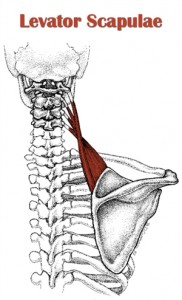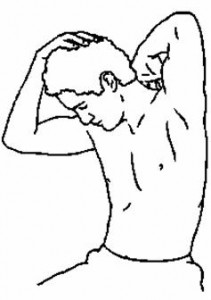Levator Scapulae – tightness and effects on handstands
I will keep this short and sweet. Future video on all of this to come.
First, this is the levator scapulae. As the name implies, it elevates the scapula. It also helps downwardly rotate the scapula.
Now, what does the scapula do when we reach our arms overhead – in pressing exercises, or handstands? – it upwardly rotates.
So if the levator scapula is tight, what does this mean? It means that your scapulae can’t upwardly rotated correctly, and your overhead range of motion will be limited. This, in turn, compromises your alignment in a handstand. You may still easily be able to do a handstand, but I have found during my one arm handstand work, that any bit of overhead mobility that you can gain is incredibly helpful for holding a stronger one arm handstand.
The classic levator scapulae has one turn their head to one side, look downward and gently pull the head down. Others have the head stretch involved with an upward positioning of the arm, as seen in the picture below. This attacks the muscle from both sides – moving the head to stretch it, as well as upwardly rotating the scapula to stretch it.
I found this decent, but wanted to integrate some sort of movement (rather than just static stretching), as well as some soft tissue work (rolling with a lacrosse ball).
What I’ve done recently, with great success, is to take a lacrosse ball and pin it to the upright post of a squat rack right on the superior/medial edge where the levator scapula meets the shoulder blade. I am facing away from the squat rack at this point. In order to maximize the amount of force I can apply on the muscle, I scoot my hips away from the rack, so I am leaning back more into the lacrosse ball. Because I am using a squat rack post, my head can lean back and move to one side of the post.
Once in this position, I take the arm of the side I’ve pinned and I abduct it so that I’m reaching overhead. The squat rack post allows me to reach up and back, whereas a wall would not. At the end range of motion, I really stretch my arm up. Remember, that reaching overhead upwardly rotates the scapula. And I have pinned down the levator scapula with the lacrosse ball, so this movement of the arm is an excellent mobilization of that muscle.
You can also move and stretch the head/neck around with the other free arm to attack the levator scapula from the other side.
The results I’ve seen from this are nothing short of amazing. A look in the mirror beforehand shows my shoulders to be sitting symmetrically when viewed from the front. After this mobilization, the treated shoulder has dropped significantly – as the levator scapula has been relaxed.
Because of this relaxation of a major scapular downward rotator, I am better able to reach overhead and get to strengthening the weak upward rotators (serratus anterior/lower trap) – but that’s a topic for another day.
I don’t know if this post is still “short and sweet”, but read over my description and give this a go. Test and retest your overhead range of motion, as well as a visual check on the height of your resting shoulders.
Hope you find this helpful in your training. Don’t worry, video to come.
-Jim




Hey!
Been reading and using your tutorials for about two years and Im really grateful for your work.
Definitely going to try and work on the levator scapulae like instructed as it seems to cause me some shoulderblade alignment issues.
Thanks again, great work.
Moby
Great post! I’m looking forward to the video of you demoing the mobilization technique. Keep up the excellent work.
Great post! Thanks! Going to use this in mobility class next week.
This is really useful information. I’ve had my levator scapulae really tight on one side for months. I will try these stretches.
Very keen to see the video, as I have less than 180 degrees of shoulder flexion. The description makes some sense, but I don’t think I’d be able to get the ball in the right position without some more detail or pics.